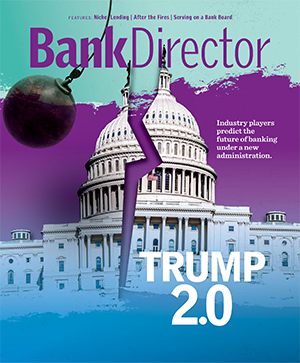Emily McCormick is Vice President of Editorial & Research for Bank Director. Emily oversees research projects, from in-depth reports to Bank Director’s annual surveys on M&A, risk, compensation, governance and technology. She also manages content for the Bank Services Program, including Bank Director’s Online Training Series. In addition to speaking and moderating discussions at Bank Director’s in-person and virtual events, Emily writes and edits for Bank Director magazine, BankDirector.com and Bank Director’s weekly newsletter, The Slant. She started her career in the circulation department at the Knoxville News-Sentinel and graduated summa cum laude from The University of Tennessee with a bachelor’s degree in Spanish and International Business.

Magazine Exclusive: Credit Storm
What will banks do when more than $1 trillion in CRE debt comes due?
The following feature appeared in the fourth quarter 2023 edition of Bank Director magazine. It and other stories are available to magazine subscribers and members of Bank Director’s Bank Services Program. Learn more about subscribing here.
In 2022, when it became evident that inflation wasn’t transitory after all, and the Federal Reserve began raising rates, Mike Kubacki, the chairman of $6.5 billion Lakeland Financial Corp., had a realization.
“Mike looked around the boardroom and said, ‘I may be the only person in this room that has ever actually been involved in business during an extreme inflationary environment, in combination with a rising rate environment.’ And he was correct,” recalls David Findlay, the CEO of Lakeland and its subsidiary, Lake City Bank in Warsaw, Indiana.
Few in banking today have experienced the one-two punch of high interest rates and high inflation last seen in the early 1980s, when the prime lending rate peaked at 21.5%. At 71, Kubacki is the oldest member of Lakeland’s board. He started his career at Chicago-based Northern Trust Corp. in 1973, working there for more than two decades before joining Lakeland as its CEO in 1998.
In some ways, it’s like the U.S. is back in the 1980s again. But today’s environment differs vastly from those days as well. The years since the 2007-08 financial crisis have featured extremely low interest rates compared to historic norms. That’s fueled lending activity, but the recent shift in Fed policy has curtailed demand and promises to have a lagging effect on credit quality. “We haven’t yet seen the full effect of all the rate hikes from the Federal Reserve,” says Brandon Koeser, a financial services senior analyst at RSM US. “I think we’re at the early stages of what’s likely going to be a multiyear period” of prolonged credit deterioration.
Some banks will struggle, due in part to a lack of experience in loan workouts. But those that act quickly and stay on top of borrowers may survive the looming credit storm better than others.
Kubacki said he’s optimistic about the bank’s ability to weather the current environment, recalls Findlay. After all, he’s been through it before. But the Lakeland chair’s comment in the boardroom sparked a deeper discussion around credit underwriting, says Findlay.
The bank doesn’t soften its underwriting standards in good times, nor does it tighten them in weaker conditions. But they’re factoring in a more challenged operating environment as they approve and monitor loans, and they’re strengthening stress testing. “We’re being very cautious as we enter into new relationships with prospects,” he says, “and being equally as cautious with existing clients” in certain sectors.
After years of easy money, “all the segments of the market are facing higher interest rates, and that’s a problem,” explains Matt Anderson, managing director at Trepp. Commercial real estate borrowers are extremely dependent on debt, around $1 trillion of which will mature in 2023-24, according to the data analytics firm. Banks hold roughly half of U.S. CRE debt. The combination of high leverage with high rates, coming as banks tighten up underwriting, could make it tough for borrowers.
Some areas of CRE, such as industrial and multifamily, will face this environment from a more sound foundation, making it easier for borrowers to weather higher rates. “For apartments, demand has been strong,” says Anderson. “Rent growth, it’s gone through ups and downs, but it’s been positive.” But nonresidential commercial — lodging, office, retail — exhibits real challenges. Delinquencies at banks have risen across all three categories since the first quarter 2020 to the same period in 2023, according to Trepp: from 0.8% to 8%, for lodging; 1.2% to 3.7%, for retail; and 0.6% to 2.7%, for office. More than $700 billion in nonresidential commercial loans will mature in 2023-24. Banks hold $417 billion of that debt.
Bankers worry about office loans the most. “Banks in particular are combing through their office portfolios very carefully,” says Anderson. “They’re treating every office loan as something that needs analysis.” The pandemic sent workers home, where many stayed, changing office use across the country and particularly in downtown, metro areas. The financial impact of those changes on borrowers has been mitigated by long leases with five or 10 year terms. Those are coming up for renewal. “We easily have a few more years of adjustment,” says Anderson, as companies reconsider how much space they need.
The same work dynamics impacting offices trickles over to other areas of nonresidential, commercial loans. Workers are less likely to frequent the same stores and restaurants that flourished during 9 to 5, Monday through Friday hours in the office. Lodging continues to recover from declines during the early days of the pandemic, says Anderson, but business travel remains down.
Banks should watch this ripple effect, says Trang Sumpter, a director in the financial services consulting practice at Moss Adams LLP. “Cash flow is definitely a concern,” she says. Tenants are asking for rent deferments or concessions, which impact landlords’ ability to repay their loans. Some institutions “are starting to see more downgrades in their loan portfolio,” she says, though the signs, in the form of charge-offs and other metrics, have been slow to appear.
Amid these concerns, in June the prudential regulators — the Office of the Comptroller of the Currency, the Federal Deposit Insurance Corp. and the Fed, as well as the National Credit Union Administration — issued a final policy statement on CRE workouts and accommodations to help “creditworthy borrowers during times of financial stress,” updating previous guidance from 2009. The 90-page document features multiple examples of CRE workouts, starting with a scenario examining an office building negatively affected by remote work. The guidance details how institutions can avoid criticism by their regulators in workouts through actions such as analyzing the borrower’s global debt service coverage, which measures whether the client has enough cash flow to repay debts.
It’s a sign from the regulators that “good faith attempts” to work with CRE borrowers won’t be subject to broad criticism about risk management, says David Ruffin, principal at the credit risk technology firm IntelliCredit. “The regulators will give them credit for jumping on it and being assertive about it.”
Underwriting has improved substantially since the passage of the Dodd-Frank Act in 2010, Ruffin adds, but it’s what happens after the loan gets booked where banks now fall short. And there’s a lot that bankers can do before a loan falls into delinquency.
Jeff Rose — now the CEO of Ambank Holdings in Davenport, Iowa — spent his early career doing workouts in Texas. The state saw a massive wave of failures in the late 1980s, tied to the ups and downs of the oil and gas sector. It’s why we use the Texas ratio metric today, which identifies problem banks by dividing nonperforming assets by the bank’s tangible common equity and loan loss reserves.
The higher the number, the more troubled the bank.
Rose learned to act quickly when a loan was headed for trouble, to determine how to minimize loss. The bank will often take additional collateral in restructuring a loan, for example. Banks that wait to act won’t have that opportunity. “If you are late to the party, there may be nothing else to grab,” he says.
Ambank’s subsidiary, $532 million American Bank & Trust Co., made a lot of loans in 2018-19 at low interest rates, around 3% or 4%. Now, those rates have roughly doubled, and he needs to know if those borrowers could be in trouble. “They may be current on payments,” he says, but if “they’re not generating enough cash flow to cover their debt service, you need to probably downgrade” the loan.
Like many community banks, American Bank & Trust and Lake City Bank leverage stress testing to identify potential problem spots in the loan portfolio. Sumpter recommends numerous stress testing variables, including interest rates and loan types as well as concentrations. “Community banks tend to focus on relationships,” she says. Consider a client with multiple loans, for instance. “If that one borrower goes bad, they’ve got this huge credit exposure to that one relationship.”
Geography, cash flow and capitalization — or cap — rates should also factor into stress testing. Cap rates calculate the expected return on investment for a property by dividing the property’s annual net operating income by its appraised value. Banks should be mindful that a property’s value may have changed since the loan was made.
Rose considers clients’ cap rates and occupancy levels as well as available financial information. But many community bank borrowers lack audited financial statements, so tax returns, prepared by a certified public accountant, are typically the best source for a clear financial picture of the client. Unfortunately, many CRE and commercial and industrial (C&I) clients haven’t filed tax returns for 2022 due to extensions, he says, making that information outdated.
“We’re not going to get the 2023 tax returns for another 15 months. We need to know where our borrowers are well before that,” says Rose. “Based upon what we know, we extrapolate the prior year and say, ‘OK, our borrower’s interest expense in 2021 was x. It is probably going to be 1.5x in 2022’” based on the Fed’s rate hikes. From there, Rose and his team can gauge their expectations for the borrower in 2023.
Staying on top of the data and working with the borrower gives lenders the necessary information to help the client and protect the bank. If costs are going up, American Bank & Trust could suggest that the client raise rental rates, for example. If several units are vacant, the bank could recommend that the borrower lower the rent. If the value of the property has declined, the borrower could petition for property taxes to be reassessed and potentially lowered — benefiting the bank in the event it has to foreclose on the property.
“Having that type of communication and discussion with our borrower is not only going to be of value to our customer, but it’s going to provide us with information so we know how to accurately risk rate the credit and decide if we even want to renew the credit,” says Rose. “We’re even going to our borrowers now that have loans maturing later this year and next year, and saying, ‘Would you like to lock in for the next five years, effective today?’” The bank can also offer a hedge for the customer against future rate increases.
Even before the Fed began raising interest rates, Findlay and his team at Lake City Bank were examining inflation’s impact on clients. Could an increase in costs be passed on to the client’s customer?
“Raw product input costs are significantly higher for the great majority of our manufacturers, as well as our companies involved in commercial real estate, between lumber and steel and oil-based products,” says Findlay. “That inflationary impact on costs of goods sold becomes part of the analysis and looking at the leverage that goes into a deal.” For CRE borrowers, that can mean analyzing loan to cost and lowering the loan to appraised value on projects, requiring more equity in the deal. The bank has “de minimis” exposure to commercial office real estate or commercial retail, according to Findlay, around 2% of the total loan portfolio. Losses remain low — just one charge off per year in 2022 and 2021, each tied to a single commercial loan.
So far, deteriorating credit quality for the industry appears to be “very one-off driven, which as an outsider makes it hard to pinpoint a specific bank or a specific market,” says Terry McEvoy, a managing director at Stephens who covers Lakeland.
Compared to past downturns, banks have more information they can leverage to understand customer relationships and various trends. The data required to comply with the current expected credit loss, or CECL, accounting standard could benefit banks, but Sumpter advises bankers to trust their instincts. “With the new CECL requirements, for some banks, they’re able to lower their allowance reserves,” she says. But just because a bank can lower its allowance doesn’t mean that it should. “That’s the part where the subjectivity comes in,” Sumpter says. “They really need to think about the risk of their portfolio as well as the composition and not just go by [the numbers].”
An early career in loan workouts was a “great education” in building relationships and minimizing risk, says Rose. But after years of pristine credit quality, the industry has fewer and fewer experienced workout pros. Many lenders didn’t even experience the 2008 financial crisis, much less the turmoil of the ‘80. And the once-prolific credit training programs offered by the industry disappeared long ago.
“The pipeline of new commercial lenders and future executives for community banks is running out,” Rose says. “I’m going to a lot of retirement parties these days for bankers who are younger than me.” He’s working to identify potential lenders and analysts at his bank who can be educated to work with borrowers through troubled loans.
A workout artist has a special touch, says Rose. He isn’t looking for a “tough banker” who will simply foreclose on a property — though sometimes that must be done. Instead, he wants an empathic professional who can foster a relationship with a problem borrower.
“You have to really know their business,” he says. The stress may be temporary for some clients, and the bank may want to continue the relationship on the other side. But getting there could take anywhere from six months to more than a year.
On Aug. 8, 2023, several lenders saw their ratings lowered by Moody’s, which cited exposure to CRE loans and expectations that asset quality will deteriorate. Banks including JPMorgan Chase & Co. and Capital One Financial Corp. have been trying to sell office debt, according to an August 2023 Bloomberg article — preferring to take a loss on the loan sale rather than deal with foreclosed property.
A foreclosure can be a huge distraction for a bank, says Rose. “If you ever get to a point where you foreclose or repossess a property … get rid of it as quickly as you can.”
For troubled credits, “the first loss is your best loss,” says Jon Winick, CEO of Clark Street Capital, which specializes in loan sales. He sees competitive pricing for loans, with plenty of bidders lining up to buy. “There’s a very strong secondary market,” he says, adding that selling a loan can help banks manage around a lack of workout expertise.
Lake City Bank isn’t staffing up for a potential downturn, says Findlay. They’re staffing for growth. “We’re adding new commercial lenders,” says Findlay, which means hiring more credit analysts and administrators. The bank maintains a consistent ratio of support staff for lenders, with one credit analyst for every three commercial bankers, and one loan administrator for every four.
The Indiana bank grew total loans by 10% to $4.9 billion in the second quarter compared to the same quarter last year. Its CRE portfolio focuses on three areas, including multifamily, primarily in Indianapolis, and health care, by financing physician-owned buildings. These types of offices, classified as owner-occupied CRE because the tenant is also the owner, tend to be stable.
Warehouse logistics distribution financing is another important piece of the loan portfolio, thriving due to the digital commerce boom and the recent construction of Amazon.com distribution centers in Fort Wayne, Elkhart and Indianapolis.
“We lend money into commercial real estate business lines that we’re familiar with and are comfortable with,” says Findlay. “If we have an existing client who has a good project, we’ll consider financing it, but we’re not out pursuing commercial office space or commercial retail space.”
Findlay doesn’t have a reduced appetite for lending, but he’s certainly aware of its impact on profitability due to higher interest rates. Compared to the second quarter 2022, Lakeland Financial’s funding costs in the second quarter 2023 were 205 basis points higher, rising from 0.32% to 2.37%. The FDIC reported a similar increase for all insured institutions over the same period, with the cost of funds climbing 131 basis points to 2.05%.
“Sometimes you have to manage through a tighter net interest margin,” Findlay says. “We haven’t contracted our appetite for lending, and we don’t intend to.” Lakeland Financial’s net interest margin actually ticked up slightly year-over-year, at 3.28% as of the second quarter.
That appetite contrasts with the Federal Reserve’s July 2023 Senior Loan Officer Survey on Bank Lending Practices, which found tightened underwriting standards and reduced demand across loan types, including commercial real estate and C&I.
Rose has seen some disbelief from borrowers that rates are as high as they are. “I can’t make you a 5.5% loan or a 6% loan; it’s now 750 or seven and a quarter, it might even start with an eight,” he says. “There’s still some institutions that are doing those lower rate deals. We’re letting them walk.”
Findlay sees similar challenges in getting customers to switch lenders due to long-term loans made in the low rate environment. He recently met with a prospective client who said, “‘I’d love to switch to you guys but I can’t, because of the fixed rate loans on my books today that you can’t replicate rate on,’” he recalls. “In a lower interest rate environment, we could … give the prospect a competitive rate.”
The double digit interest rates of the 1980s remain fresh in Rose’s memory, and he’s preparing his lenders for “higher for longer” until the Fed wins its inflation war. “When a firefighter puts out a fire, they don’t just leave. They stick around and make sure that the fire is all the way out,” he says. “[The Fed will] get inflation to where they want it to be, but then they’re not going to necessarily turn off the spigot.”
That means the pressures on CRE could take months or even years to resolve. “That’s the $1.2 trillion question,” says Anderson.



